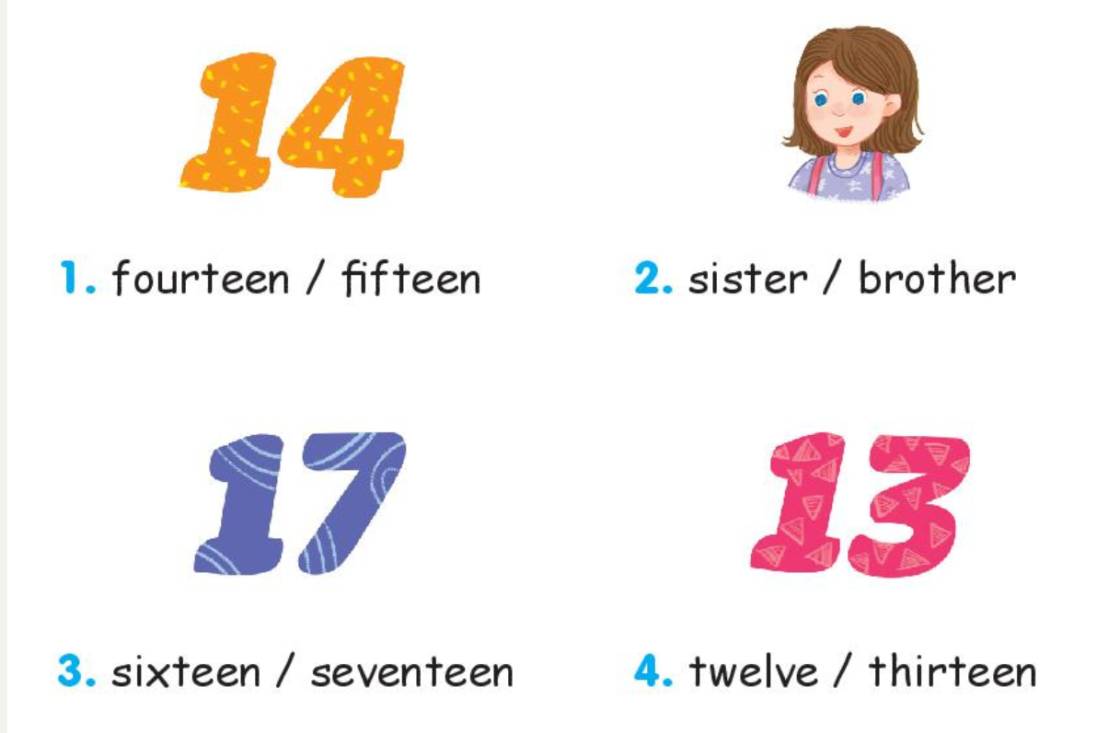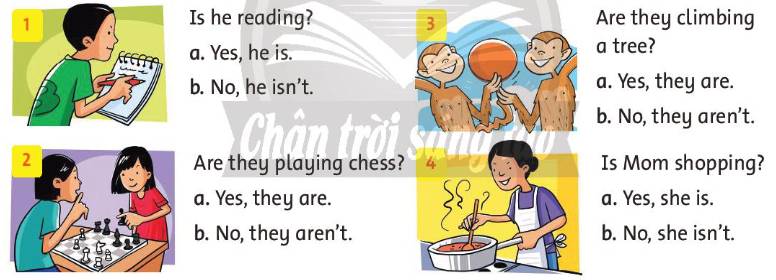Look, read, and circle.

Tuyển Cộng tác viên Hoc24 nhiệm kì 26 tại đây: https://forms.gle/dK3zGK3LHFrgvTkJ6
Read the Reading Strategy. Then complete these tasks.
1 Look at question 1 in exercise 4. Read the second paragraph of the text.
2 Circle the correct option and identify the sentence of the paragraph which gives the answer.
3 Which words are used in the sentence instead of the words in the correct option?
A perfect companion
A: Hello there.
B: How are you?
A: I am doing very well. How are you?
B: Fine.
A: Glad to hear it. What's for today?
B: Nothin'.
A: Fair enough. What do you want to study?
B: I dunno.
A: You don't know what you want to study?! Lazy humans!
B: Say what I need to study.
A: You have not yet told me what you want to study.
This conversation is between a visually-impaired student, Nick, and his digital tutor named Ann Sullutor.
Ann Sullutor is the brainchild of a 22nd century scientist modelled on and named after the dedicated tutor of Helen Keller. You can have conversations with Ann Sullutor via a wristwatch or any piece of jewellery. The idea of the digital tutor was to help disabled children study in mainstream schools.
Early in the morning, Ann Sullutor wakes up from a full charge of energy, ready for a 20-hour non-stop working day. Nick is quite independent in familiar situations, but if he comes across something unexpected, he can turn to Ann Sullutor for help by using his voice to control the watch on this wrist. Similarly, if he is in an unfamiliar place, he can get directions from Ann through a tiny set of earphones. In an emergency, for example, if there is an obstacle or unexpected vehicle, Nick receives a tiny vibration as a warning. Ann sends reports to the child's parents on a regular basis or on demand.
Registered in the school system and equipped with an immense database, Ann can easily keep track of Nick's schedule and curriculum. During class, Ann gives off a warning beep when Nick is distracted, quicky converts the new material into braille or dictates what the teacher has just written on board. Ann is there to bridge the gap between Nick and his classmates. In Nick's individual sessions, Ann suggests lessons depending on his preference and ability. She can adapt the lesson to aid Nick's learning process, but she doesn't jump in immediately to offer him a hand. Nick has to work on his own for a while before Ann makes a few suggestions. She may even ask Nick to read some extra materials to get a grasp of the topic. Nick often complains about Ann's persistence and strictness. In his fury, Nick sometimes does wish to turn Ann off for a while, which can only be done by his parents.
Ann Sullutor is much more than a beautifully-designed gadget for a visually-impaired child. She can make a perfect companion to any child that needs a tutor or a friend to talk with.
Reading Strategy In a multiple-choice question, the correct option will match the meaning of the text but use different words. It is therefore important not to automatically assume that a multiple-choice option which contains words from the text is correct. |
* Câu hỏi 1 bài tập 4
1 Ann Sullutor
a is an invention of the 22nd century.
b costs a huge sum of money.
c takes a 20-hour energy charge.
d can't be controlled orally.
Thông tin: “Ann Sullutor is the brainchild of a 22nd century scientist”
(Ann Sullutor là sản phẩm trí tuệ của một nhà khoa học thế kỷ 22.)
Chọn A
Từ được dùng trong câu thay cho từ phương án đúng là: “brainchild” (sản phẩm trí tuệ) thay thế cho “invention” (sự phát minh)
6. Read the Look out! box above and the dialogue below. Circle the correct words to complete the dialogue. Then listen and check.
(Đọc hộp chú ý! ở phía trên và đoạn hội thoại phía dưới. Khoanh tròn các từ đúng để hoàn thành đoạn hội thoại. Sau đó nghe và kiểm tra.)
LOOK OUT! (Chú ý)
In affirmative sentences, much and many often sound very formal. In everyday English, we use a lot of.
(Trong các câu khẳng đinh, much và many nghe có vẻ trang trọng hơn. Trong tiếng Anh hằng ngày, chúng ta dùng a lot of.)
Jack: Look, there's a building with (1) many / some people outside. Turn left just before you get there.
Evie: I can't see (2) any / some people. There isn't (3) many / much light. Hey! What's that noise?
Jack: Nothing. There was (4) any / some rubbish in the road.
Evie: I hate this part of town. There aren't (5) a few/ many nice areas. Let's go north.
Jack: How (6) many / much fuel have we got? Only (7) a few / a little litres.
Evie: Oh no, listen. The police are chasing us now.
Jack: Let me drive. I know (8) a few/ a little tricks.
Mum: Jack, are you doing (9) any / many homework in there?
Jack: Er ... Yes. We're doing (10) a little/ much IT homework.
Evie: Jack! That's not true ...
Jack: Well, we're spending (11) a lot of/ a few time on the computer!
Evie: But we aren't doing (12) some / any work!
1.some | 2. any | 3. much | 4. some | 5. many | 6. much |
7. a few | 8. a few | 9. any | 10. a little | 11. a lot of | 12. any |
Read the text below and then decide which word, (A, B, C or D), best fits each space. Circle the correct
answer. There is an example at the beginning (0).
A NEW LOOK AT THE MIDDLE AGES
The Institute for Medieval Studies is holding a series of lectures to (0) __generate__ interest in a
period of history which is all too often(41)________. It is hoped that these lectures will (42)________
3
some of the misconceptions that (43)________ to this day about the long and eventful span of time
between the crowning of Charlemagne and Renaissance.
It is true that Europe was (44)________ by the plague in the latter part of the fourteenth century,
while the terrors of the Inquisition cast a grim (45)________ over the continent. Living conditions for the
majority of people were appalling by modern standards, and life expectancy was low. The peasants
suffered under a brutal feudal system and the (46)________ of learning was open only to the clergy and
the small minority who were literate.
However, these (47)________ negative aspects of medieval life cannot be properly evaluated unless
they are viewed in the broader (48)________. The Middle Ages saw the construction of the magnificent
cathedrals that (49)________ so many European cities and the (50)________ of a middle class. Many
institutions we think of as modern were a(n) (51)________ part of medieval life. Progress was being made
in science and technology, and artists were (52)________ styles that had a powerful and (53)________
influence on subsequent centuries.
| 0 | A | generate | B | adopt | C | define | D | Cause |
| 41. | A | neglected | B | abandoned | C | subdued | D | Deserted |
| 42. | A | respond | B | refuse | C | rectify | D | Revive |
| 43. | A | insist | B | persist | C | consist | D | Desist |
| 44. | A | injured | B | eliminated | C | wounded | D | ravaged |
| 45. | A | shade | B | shadow | C | eclipse | D | twilight |
| 46. | A | pursuit | B | chase | C | desire | D | quest |
| 47. | A | potentially | B | admittedly | C | dubiously | D | comprehensively |
| 48. | A | background | B | setting | C | context | D | environment |
| 49. | A | grace | B | delight | C | decorate | D | illuminate |
| 50. | A | debut | B | invention | C | introduction | D | rise |
| 51. | A | total | B | entire | C | seamless | D | integral |
| 52. | A | etching | B | welding | C | forging | D | carving |
| 53. | A | maintaining | B | enduring | C | remaining | D | sustaining |
41 A
42 C
43 D
44 D
45 B
46 A
47 D
48 C
49 A
50 C
51 D
52 A
53 D
2. Look again and circle.
(Nhìn lại và khoanh chọn.)

- bike: xe đạp
- pasta: mì ống
- pizza:bánh pi-za
- sail: con thuyền
- sea: biển
- rainbow: cầu vồng
- road: con đường
- kitten: mèo con
2. Look again and circle.
(Xem lại và khoanh chọn.)

- juice: nước ép
- village: ngôi làng
Task 2. Look again and circle.
(Xem lại và khoanh chọn.)

- grapes: chùm nho
- cake: bánh
- riding: đạp xe
Task 2. Look again and circle.
(Xem lại và khoanh tròn.)

- fifteen: 15, số 15
- brother: anh/ em trai
- shirts: áo sơ mi
Read and circle.

1. They weren't at the park yesterday. (Họ đã không ở công viên ngày hôm qua.)
2. It wasn't rainy. (Trời không mưa.)
3. The sea was cold. (Biển không lạnh.)
4. The children were hungry. (Bọn trẻ đói.)
5. The sandwiches weren't small. (Những chiếc bánh mì không nhỏ.)
Task 1. Look and circle. Then say.
(Nhìn và khoanh tròn. Sau đó nói.)

Read and circle a or b.

1. b | 2. a | 3. a | 4. b |
1. Is he reading? (Có phải anh ấy đang đọc không?)
No, he isn’t. (Không phải anh ấy.)
2. Are they playing chess? (Có phải họ đang chơi cờ không?)
Yes, they are. (Đúng là họ.)
3. Are they climbing a tree? (Có phải chúng đang leo cây không?)
Yes, they are. (Đúng vậy.)
4. Is mom shopping? (Có phải mẹ đang đi mua sắm không?)
No, she isn’t. (Không phải bà ấy.)